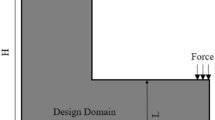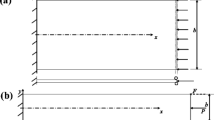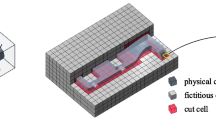Abstract
This study used an adaptive mapping technique to examine multiscale bucking optimal topology for structural coating. The adaptive geometric components (AGCs) include a framework of macro-sandwich bars representing a macrostructure with a solid coating and a group of micro-solid bars representing the nonuniform concurrent at the microstructural scale. The layout of optimized design, comprising the coated layer, and the interior microscale are together designed with buckling constraints. The properties of material change in a certain direction in response to a specified variation in the macro- and microstructures, designed using functionally graded materials. Examining the optimal AGC geometries under buckling constraints yielded a structure with asymmetric stiffness qualities. Furthermore, a comparison of different structures, including solid, lattice, and coating of concurrent structures, under buckling constraint was conducted and is presented herein. The some examples of maximizing structural stiffness, used as an objective under buckling constraints, confirm that the approach of proposed method works effectively and yields satisfactory results.



































Similar content being viewed by others
References
Zhang P, Toman J, Yu Y, Biyikli E, Kirca M et al (2015) Efficient design-optimization of variable-density hexagonal cellular structure by additive manufacturing: theory and validation. J Manuf Sci Eng Trans ASME 137:41–50
Wang X, Zhang P, Ludwick S, Belski E, To AC (2018) Natural frequency optimization of 3D printed variable-density honeycomb structure via a homogenization-based approach. Addit Manuf 20:189–198
Zhang W, Li D, Zhou J, Du Z, Li B, Guo X (2018) A moving morphable void (MMV)-based explicit approach for topology optimization considering stress constraint. Comput Methods Appl Mech Eng 334:381–413
Wu J, Wang CCL, Zhang X, Westermann R (2016) Self-supporting rhombic infill structures for additive manufacturing. CAD Comput Aided Des 80:32–42
Hoang VN, Tran P, Nguyen NL, Xuan HN (2020) Adaptive concurrent topology optimization of coated structures with nonperiodic infill for additive manufacturing. CAD Comput Aided Des 129:1202918
Bendsoe MP (1989) Optimal shape design as a material distribution problem. Struct Optim 1:193–202
Sofiyev AH (2019) Review of research on the vibration and buckling of the FGM conical shells. Compos Struct 211:301–317
Allaire G, Jouve F, Toader AM (2002) A level set method for shape optimization. C R Math 334:1125–1130
Wang MY, Wang X, Guo D (2003) A level set method for structural topology optimization. Comput Methods Appl Mech Eng 192:227–246
Xie YM, Steven GP (1993) A level set method for structural topology optimization. Comput Struct 49:885–896
Saxena A (2011) Topology design with negative masks using gradient search. Struct Multidiscip Optim 44:629–649
Guo X, Zhang W, Zhong W (2014) Doing topology optimization explicitly and geometrically—a new moving morphable components based framework. J Appl Mech 81:081009
Norato JA, Bell BK, Tortorelli DA (2015) A geometry projection method for continuum-based topology optimization with discrete elements. Comput Methods Appl Mech Eng 293:306–327
Hoang VN, Jang GW (2017) Topology optimization using moving morphable bars for versatile thickness control. Comput Methods Appl Mech Eng 371:153–173
Hoang VN, Nguyen NL, Xuan HN (2020) Topology optimization of coated structure using moving morphable sandwich bars. Struct Multidiscip Optim 61:491–506
Wang X, Long K, Hoang VN, Hu P (2018) An explicit optimization model for integrated layout design of planar multi-component systems using moving morphable bars. Comput Methods Appl Mech Eng 342:46–70
Guo X, Zhou J, Zhang W, Du Z, Liu C, Liu Y (2017) Self-supporting structure design in additive manufacturing through explicit topology optimization. Comput Methods Appl Mech Eng 323:27–63
Zhang W, Liu Y, Du Z, Zhu Y, Guo X (2018) A moving morphable component based topology optimization approach for rib-stiffened structures considering buckling constraints. J Mech Des 140:111404
Zhang S, Norato JA (2017) Optimal design of panel reinforcements with ribs made of plates. J Mech Des 139:081403
Liu C, Du Z, Zhang W, Zhu Y, Guo X (2017) Additive manufacturing-oriented design of graded lattive structures through explicit topology optimization. J Appl Mech 84:081008
Deng J, Pedersen CBM, Chen W (2019) Connected morphable components-based multiscale topology optimization. Front Mech Eng 14:129–140
Hoang VN, Nguyen NL, Tran P, Qian M, Xuan HN (2020) Adaptive concurrent topology optimization of cellular composites for additive manufacturing. JMO 72:2378–2390
Sivapuram R, Dunning PD, Kim HA (2016) Simultaneous material and structural optimization by multiscale topology optimization. Struct Multidiscip Optim 54:1267–1281
Xia L, Breitkopf P (2014) Concurrent topology optimization design of material and structure within FE2 nonlinear multiscale analysis framework. Comput Methods Appl Mech Eng 278:524–542
Li H, Luo Z, Gao L, Qin Q (2018) Topology optimization for concurrent design of structures with multi-patch microstructures by level sets. Comput Methods Appl Mech Eng 331:536–561
Yan J, Guo X, Chan G (2016) Multi-scale concurrent material and structural design under mechanical and thermal loads. Comput Mech 57:437–446
Xia L, Breitkopf P (2017) Recent advances on topology optimization of multiscale nonlinear structures. Arch Comput Methods Eng 24:227–249
Vincente WM, Zuo ZH, Pavanello R, Calixto TKL, Picelli R, Xie YM (2016) Concurrent topology optimization for minimizing frequency responses of two-level hierarchical structures. Comput Methods Appl Mech Eng 301:116–136
Bendsoe MP, Kikuchi N (1988) Generating optimal topologies in structural design using a homogenization method. Comput Methods Appl Mech Eng 71:197–224
Groen JP, Sigmun O (2018) Homogenization-based topology optimization for high-resolution manufacturable microstructures. Int J Numer Methods Eng 113:1148–1163
Clausen A, Aage N, Sigmund O (2015) Topology optimization of coated structures and material interface problems. Comput Methods Appl Mech Eng 290:524–541
Wu J, Wang W, Gao X (2019) Design and optimization of conforming lattice structures. IEEE Trans Vis Comput Graph 27
Wu J, Sigmund O, Groen PJ (2021) Topology optimization of multi-scale structures: a review. Struct Multidiscip Optim 63:455–1480
Clausen A, Aage N, Sigmund O (2016) Exploiting additive manufacturing infill in topology optimization for improved buckling load. Engineering 2:250–257
Youn GH, Yi B (2019) A new coating filter of coated structure for topology optimization. Struct Multidiscip Optim
Wang Y, Kang Z (2018) A level set method for shape and topology optimization of coated structures. Comput Methods Appl Mech Eng 329:553–574
Fu J, Li H, Xiao M, Gao L, Chu S (2019) Topology optimization of shell-infill structures using a distance regularized parametric level-set method. Struct Multidiscip Optim 59:249–262
Rahmatalla S, Swan CC (2003) Continuum topology optimization of buckling-sensitive structure. AIAA J 41(6):1180–1189
Gao X, Ma H (2014) A new method for dealing with pseudo modes in topology optimization of continua for free vibration. Lixue Xuebao/Chin J Theor Appl Mech 46(6):739–746
Gao X, Ma H (2015) Topology optimization of continuum structures under buckling constraints. Comput Struct 157:142–152
Doan QH, Lee DK (2017) Optimum topology design of multi-material structures with non-spurious buckling constraints. Adv Eng Softw 114:110–120
Doan QH, Lee DK, Lee JH, Kang JW (2019) Design of buckling constrained multiphase material structures using continuum topology optimization. Meccanica 54:1179–1201
Dunning PD, Ovtchinnikov E, Scott J, Kim HA (2016) Level-set topology optimization with many linear buckling constraints using an efficient and robust eigen solver. Int J Numer Methods Eng 107(12)
Svanberg K (1987) The method of moving asymptotes-a new method for structural optimization. Int J Numer Methods Eng 24(2):359–373
Olhoff N, Rasmussen SH (1977) On single and bimodal optimum buckling loads of clamped columns. Int J Numer Methods Eng 13(7):605–614
Radhika N, Teja K, Rahul K, Shivashankar A (2018) Fabrication of Cu-Sn-Ni /SiC FGM for automotive applications: investigation of its mechanical and tribological properties. Environ Sci Pollut Res 10:1705–1716
Paulino GH, Sutradhar A, Gray JL (2002) Boundary element methods for functionally graded materials. Bound Elem 4:1705–1716
Silva NCA, Paulino GH (2004) Topology optimization applied to the design of functionally graded material (FGM) structures. In: Proceedings of 21st international congress of theoretical and applied mechanics(ICTAM), pp 15–21
Paulino GH, Silva NCA (2005) Design of functionally graded structures using topology optimization. J Appl Mech 492–493:435–440
Banh TT, Luu NG, Lee DK (2021) A non-homogeneous multi-material topology optimization approach for functionally graded structures with cracks. Compos Struct 273:114230
Li H, Gao L, Li H, Tong H (2020) Spatial-varying multi-phase infill design using density-based topology optimization. Comput Methods Appl Math 372:113354
Zhou Y, Gao L, Li H (2022) Graded infill design within free-form surfaces by conformal mapping. Int J Mech Sci 224:107307
Acknowledgements
This research was supported by the National Research Foundation of Korea (NRF) grant funded by the Korea government (MSIT) (No. 2022R1A2C1003776).
Author information
Authors and Affiliations
Corresponding author
Ethics declarations
Conflict of interest
The authors declare that they have no conflict of interest.
Additional information
Publisher's Note
Springer Nature remains neutral with regard to jurisdictional claims in published maps and institutional affiliations.
Rights and permissions
Springer Nature or its licensor holds exclusive rights to this article under a publishing agreement with the author(s) or other rightsholder(s); author self-archiving of the accepted manuscript version of this article is solely governed by the terms of such publishing agreement and applicable law.
About this article
Cite this article
Ngoc, N.M., Hoang, VN. & Lee, D. Concurrent topology optimization of coated structure for non-homogeneous materials under buckling criteria. Engineering with Computers 38, 5635–5656 (2022). https://doi.org/10.1007/s00366-022-01718-2
Received:
Accepted:
Published:
Issue Date:
DOI: https://doi.org/10.1007/s00366-022-01718-2




